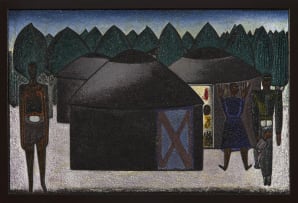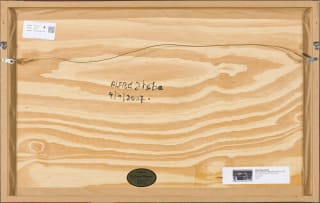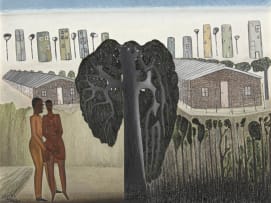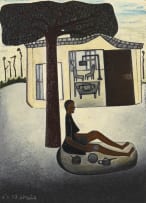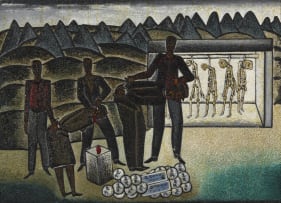The Oliver Powell and Timely Investments Trust Collection
Live Virtual Auction, 20 September 2022
The Oliver Powell and Timely Investments Trust Collection
About the SessionStrauss & Co is pleased to present this extraordinary collection as the featured session this September Live Virtual Auction. An established insolvency practitioner with a passion for the arts, Oliver Powell's principal focus has been collecting South African painting, sculpture and works on paper made since 1950. Colour, graphic ingenuity and emotional weight are all attributes in an artwork that Powell is drawn to. Powell also emphasises the importance of his many encounters with artists. “There is so much value in meeting an artist,” says Powell. “Aspects and details of their life are reflected in what and how they paint.”
Incl. Buyer's Premium & VAT
About this Item
signed and dated 4/2/2007 on the reverse and inscribed with the artist's name, title, and medium on a label adhered to the reverse
Notes
The category of 'Outsider Art' has received much mainstream attention in the last few years, including Lynne Cook's curation of Outliers and American Vanguard Art (2018) at the National Gallery of Art in Washington, and then a year later, the first auction of "Outside and Vernacular Art" by Christie's New York in 2019 (and followed annually since then by sales in the Outsider Art category). Such is the extent of its mainstreaming that even Christie's own publicity for their auctions invokes the "master" narrative, characterising the work as "masterpieces" and the artists as "self-taught masters".1
In its reach, which is neither easy nor simple, 'Outsider Art' (and its precursor, 'Art Brut') is seen to include artists who are not formally trained, who are 'outside' the mainstream artworld, who create elaborate fantasy worlds, and/or who have a mental illness. While it is not a style, the use of 'naïve' often gets pushed in the face of Outsider Art, and especially in auction sales it often sits in proximity to traditional 'African' and 'Oceanic' art, as well as 'folk' art, with certain implications for what they are understood to share.
At face value, Alfred Thoba fits many of the criteria used to characterise 'Outside Art'. He has no formal training as an artist, with his singular early approach to Bill Ainslie for lessons rebuffed by the latter because he thought Thoba had a 'natural' talent.2 In Thoba's own characterisation of the encounter, "I went to them [Ainslie] with [my emphasis] the knowledge; I was actually born with it".3 There are no apparent art historical references in Thoba's work, and in interviews I conducted with him, he never once mentioned another artist of his own accord.
This disregard for other art and the art histories that surround them is less about a disparaging of other artists as it is about Thoba's own understanding of the role of painting as a convenient medium, not only to release the messages that thicken and congeal inside his head, but also to travel these messages into public. The vitality of these messages is reiterated in the letters that accompany Thoba's paintings, earnestly written to ensure that whoever buys the painting properly understands its meaning. Oftentimes Thoba seems genuinely unconcerned with the currency of his paintings as art objects, or the place of his paintings in an art historical tradition or canon. Instead, the significance of a sale is as much about the successful transmission of a message as it is about the financial gain. This world constituted by Thoba's messages is a complex fantasy of autobiography, readings, obsessions, trickery, cosmologies, dreams, visions, and morality. While they are highly personal, and often autobiographical, Thoba himself very rarely appears in his own paintings.
Thoba's painterly technique has little academic reference and is instead derived from the release he experiences through the unique process of the thickly applied paint, carefully built up into areas of relief and teased into peaks using with a variety of tools. It is obsessive, time-consuming work, and the quality of his attention to detail is clearly reflected in the intricacies and nuances of the finely teased paint.
Thoba has fallen in and out with many of the prominent dealers and galleries in South Africa. It created a consequent pattern of him moving in and out of the artworld, but ultimately contributing to a sense of what oftentimes feels like an outsider status. Mention his name inside the mainstream artworld and the response is either a blank stare, or a sketchy reference to his 1976 Riots painting that was shown at the Detention Without Trial: 100 Artists Protest exhibition in 1988, and reproduced in Sue Williamson's book, Resistance Art in South Africa (1989), then disappeared for more than 20 years before being sold at Strauss and Co for close to R1 million in 2012.4
Why isn't 'Outsider Art' a more feted category here and why isn't Thoba celebrated as a significant artist in this categorical formulation? Mostly because there are more significant flaws in the category, not least of which is its intersection apartheid history. The most obvious flaw with 'Outsider Art' is the normative assumptions it makes in framing the category, notably in terms of what is understood as 'normal' (and thereby inside). 'Outsider Art' reads as a litany of negatives, and of what is not.
The second flaw is that 'Outsider Art' adopts a static understanding of makers within the category, a failing that is most obviously exposed when outsider artists become part of major museum collections. This schizophrenic parallel habitation of outside but inside is an ambivalence easily tolerated by the mainstream art world.
But it is the third flaw in the understanding of 'Outsider Art' that is most relevant especially in the South African context, and this is the extent to which the category is complicated by colonial and apartheid histories that deliberately prejudiced black artists in terms of not only formal art education (and where such education was available, it was often patronising and infantilising) but also access to a mainstream 'white' artworld. Black artists were forced into living and working conditions that made their personhood and practice separate, and outside. Even in the United States, the prominent outsider artists are African-American - such as William Edmondson and Bill Traylor, both of whose parents were slaves, and whose work now commands the highest prices at auction in the 'Outsider Art' category -underscoring the parallel intersections of
the category and racial prejudice.
When Jean Dubuffet coined the original term 'Art Brut' (subsequently and largely replaced by 'Outsider Art'), it was a definition against the 'mimicry' and 'clichés' of mainstream and established art. The critical value of the 'Outsider Art' category, in spite of its assumptions and flaws, is the way in which it brings attention to the tidy intellectual formulations of art history and the rigid structures of the established artworld. If Thoba is uninterested in art history, how do we constitute art history's interest in Thoba's work? The awkwardness of 'Outsider Art' in the South African context is exactly it's value in being an important signal that South African art history needs reimagination, and that the traditional distinctions in time and place, habitually used to understand South African art, don't work to comprehend the significance and importance of Thoba's oeuvre within local and international contexts.
-Rory Bester, 2022
1. See 'Christie's New York Presents Outsider Art', 19 January 2022. Source: https://www.christies.com/about-us/press-archive/details?PressReleaseID=10344&lid=1.
2. Per communication with Gail Behrmann, 2018.
3. In Rina Minervini (1990) 'Thoba: Tolerating art with love', Sunday Star (Review section), 4 February, page 10.
4. See https://www.straussart.co.za/auctions/lot/11-jun-2012/409.
Provenance
Warren Siebrits Fine Art, Johannesburg, 22 May 2008.
The Oliver Powell and Timely Investments Trust Collection.
Exhibited
Wits Art Museum, Johannesburg, Alfred Thoba: A Step Becomes a Statement, 13 March to 3 June 2018.
Literature
Warren Siebrits (2008) Alfred Thoba: Making War to the World About Images of God, Johannesburg: Warren Siebrits, illustrated, unpaginated.


